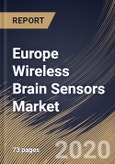The Europe Wireless Brain Sensors Market is expected to witness market growth of 12.3% CAGR during the forecast period (2020-2026).
Brain assessment is a complicated process, which requires costly and advanced tools that are mainly found in hospitals only. Technologically advanced equipment is being utilized broadly in hospitals to give better treatment. This equipment improves treatment procedures as well as gives better, faster, and precise outcomes. Generally, all neurological diseases and problems, including severe TBIs, are diagnosed and treated with the assistance of advanced equipment utilized by professional neurologists, which are accessible in hospitals with the specialty. Hospitals also witness a fundamentally higher inflow of patients experiencing head injuries, when contrasted with clinics and other end-users.
Leading organizations working in the market for wireless brain sensors are the emphasis on R&D to grow technologically progressed items to get a competitive edge. For example, in June 2020, EMOTIV introduced EPOC X, which is intended for scalable and contextual human brain research, permits access to professional-grade brain information with an enhanced and simple-to-utilize design.
Portability, lower risk of allergic reactions or disease, and innovative progressions are the significant leading drivers for the development of the Global Wireless Brain Sensor Market. Huge innovative advances in brain-computer interfaces have been prompting constant development of brain sensors and can be observed occasionally from a homecare environment making the device more cost-effective. Untapped market and innovative progressions may create possibilities in the forecast period.
Based on End Use, the market is segmented into Multispecialty hospitals, Research institutes and Others. Based on Product, the market is segmented into Electroencephalography (EEG) Devices, Sleep Monitoring Devices, Intracranial Pressure (ICP) Monitors, Transcranial Doppler (TCD) Devices and Others. Based on Application, the market is segmented into Traumatic Brain Injuries, Parkinson's Disease, Epilepsy, Dementia and Others. Based on countries, the market is segmented into Germany, UK, France, Russia, Spain, Italy, and Rest of Europe.
The market research report covers the analysis of key stake holders of the market. Key companies profiled in the report include Novo Nordisk A/S, Koninklijke Philips N.V., Natus Medical Incorporated, Neuroelectrics, Brain Products GmbH, NeuroSky, Inc., Advanced Brain Monitoring, Inc., Hangzhou Zhongheng Electric Co., Ltd., Neuronetrix Solutions, LLC and EMOTIV, Inc.
Scope of the Study
Market Segmentation:
By End Use
By Product
By Application
By Country
Companies Profiled
Unique Offerings from the Publisher
Brain assessment is a complicated process, which requires costly and advanced tools that are mainly found in hospitals only. Technologically advanced equipment is being utilized broadly in hospitals to give better treatment. This equipment improves treatment procedures as well as gives better, faster, and precise outcomes. Generally, all neurological diseases and problems, including severe TBIs, are diagnosed and treated with the assistance of advanced equipment utilized by professional neurologists, which are accessible in hospitals with the specialty. Hospitals also witness a fundamentally higher inflow of patients experiencing head injuries, when contrasted with clinics and other end-users.
Leading organizations working in the market for wireless brain sensors are the emphasis on R&D to grow technologically progressed items to get a competitive edge. For example, in June 2020, EMOTIV introduced EPOC X, which is intended for scalable and contextual human brain research, permits access to professional-grade brain information with an enhanced and simple-to-utilize design.
Portability, lower risk of allergic reactions or disease, and innovative progressions are the significant leading drivers for the development of the Global Wireless Brain Sensor Market. Huge innovative advances in brain-computer interfaces have been prompting constant development of brain sensors and can be observed occasionally from a homecare environment making the device more cost-effective. Untapped market and innovative progressions may create possibilities in the forecast period.
Based on End Use, the market is segmented into Multispecialty hospitals, Research institutes and Others. Based on Product, the market is segmented into Electroencephalography (EEG) Devices, Sleep Monitoring Devices, Intracranial Pressure (ICP) Monitors, Transcranial Doppler (TCD) Devices and Others. Based on Application, the market is segmented into Traumatic Brain Injuries, Parkinson's Disease, Epilepsy, Dementia and Others. Based on countries, the market is segmented into Germany, UK, France, Russia, Spain, Italy, and Rest of Europe.
The market research report covers the analysis of key stake holders of the market. Key companies profiled in the report include Novo Nordisk A/S, Koninklijke Philips N.V., Natus Medical Incorporated, Neuroelectrics, Brain Products GmbH, NeuroSky, Inc., Advanced Brain Monitoring, Inc., Hangzhou Zhongheng Electric Co., Ltd., Neuronetrix Solutions, LLC and EMOTIV, Inc.
Scope of the Study
Market Segmentation:
By End Use
- Multispecialty hospitals
- Research institutes
- Others
By Product
- Electroencephalography (EEG) Devices
- Sleep Monitoring Devices
- Intracranial Pressure (ICP) Monitors
- Transcranial Doppler (TCD) Devices
- Others
By Application
- Traumatic Brain Injuries
- Parkinson's Disease
- Epilepsy
- Dementia
- Others
By Country
- Germany
- UK
- France
- Russia
- Spain
- Italy
- Rest of Europe
Companies Profiled
- Novo Nordisk A/S
- Koninklijke Philips N.V.
- Natus Medical Incorporated
- Neuroelectrics
- Brain Products GmbH
- NeuroSky, Inc.
- Advanced Brain Monitoring, Inc.
- Hangzhou Zhongheng Electric Co., Ltd.
- Neuronetrix Solutions, LLC
- EMOTIV, Inc.
Unique Offerings from the Publisher
- Exhaustive coverage
- Highest number of market tables and figures
- Subscription based model available
- Guaranteed best price
- Assured post sales research support with 10% customization free
Table of Contents
Chapter 1. Market Scope & Methodology
Chapter 2. Market Overview
Chapter 3. Europe Wireless Brain Sensors Market by End Use
Chapter 4. Europe Wireless Brain Sensors Market by Product
Chapter 5. Europe Wireless Brain Sensors Market by Application
Chapter 6. Europe Wireless Brain Sensors Market by Country
Chapter 7. Company Profiles
Companies Mentioned
- Novo Nordisk A/S
- Koninklijke Philips N.V.
- Natus Medical Incorporated
- Neuroelectrics
- Brain Products GmbH
- NeuroSky, Inc.
- Advanced Brain Monitoring, Inc.
- Hangzhou Zhongheng Electric Co., Ltd.
- Neuronetrix Solutions, LLC
- EMOTIV, Inc.
Methodology

LOADING...








